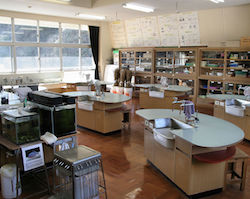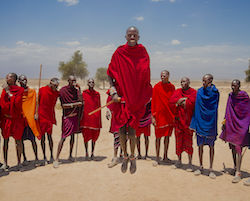
Illustrated by: Denise Inguito

Have you ever felt your gut turn into a nervous knot as you looked over a room full of lab benches? Scanning for empty seats among people looking for their notebooks, maybe you felt desperate to find a friend. Choosing your seat means choosing your lab partners for the rest of the year. And you really don't want to get stuck with a lazy lab partner and have to do twice the work!
But in the end, does taking advantage of a partner really make a person better off? What makes cooperation work, and when does cheating backfire? Cooperation theorist Athena Aktipis works to answer questions like these. She even cooperates with other scientists to create new theories about cooperation and conflict.
Cooperating or Cheating in a Computer
To find answers, Aktipis makes models of virtual worlds, where she fast-forwards time to see how a partner’s behavior affects them in the future. She sets up games where computer-programmed players use different strategies and collect points. The rules are simple and are meant to represent ones that human partners, plants, animals or even single cells could follow. Then, she sees what rules work best after many rounds of her virtual game.

Aktipis’ first model answered a simple question - what would happen if, instead of punishing cheaters, people simply walked away from them? Although it seems smart to force cheaters to change their ways, in the end the virtual partners who walked away were better off than those who stayed. Cheaters could no longer profit off cooperators, because cooperators were all paired up with other cooperators in happy long-term partnerships.
Getting Help From the Maasai
Aktipis chose a great partner when she paired up with a scientist who studies life in small tribes in Africa. One tribe she works with, the Maasai, depend on cattle for food. If a natural disaster strikes and kills off a farmer’s cattle, the Maasai have two ways of helping. One way is to give cattle to the person in need, but expect them to pay back their debt in a few years. Another way is to gift a neighbor cattle without expecting repayment, only the promise that they will help them too if they need it someday.

This second relationship is called osotua. It literally translates to umbilical cord. In this relationship, there are two highly honored rules: ask only if you are in need, and give whatever you can when asked. By simulating many years of either debt or osotua partnerships, Aktipis found that osotua gives both partners more stable herds for longer.
Cheating and Disease
Aktipis has also cooperated with many different scientists to look at how cheating that happens inside our own bodies leads to diseases. Her new theories are often inspired by her models.

For instance, humans are made of many tiny cells that all work together to keep us going. However, cheater cells can form in our bodies, and quickly ruin the harmony. Those cheaters are what we call cancer. Aktipis has worked with cancer researchers to show that cancerous cells break a kind of osotua relationship in our body by asking for more resources than they need. When the environment around them has no food and too many toxins, they “walk away” from the toxic environment that they created by spreading to other parts of the body.
Unfortunately, cheaters pop up in all kinds of partnerships. Aktipis thinks that groups need a way to punish or control cheaters for cooperators to have a leg up. But, when the rules that stop conflict are in place, cooperation wins. A great partnership makes both partners happier and more secure in the long run. So, the next time you are mad at someone for cheating, save your energy. Find a cooperator to work with instead, and make sure you help when you are able and ask only if in need.
Cooperation or Conflict was created in collaboration with The Biodesign Institute at ASU. Visit Athena Aktipis's website to learn more about her research.
Read more about: Cooperation or Conflict?
Bibliographic details:
- Article: Cooperation or Conflict?
- Author(s): Ioulia Bespalova
- Publisher: Arizona State University School of Life Sciences Ask A Biologist
- Site name: ASU - Ask A Biologist
- Date published:
- Date accessed:
- Link: https://askabiologist.asu.edu/explore/cooperation-conflict
APA Style
Ioulia Bespalova. (). Cooperation or Conflict?. ASU - Ask A Biologist. Retrieved from https://askabiologist.asu.edu/explore/cooperation-conflict
Chicago Manual of Style
Ioulia Bespalova. "Cooperation or Conflict?". ASU - Ask A Biologist. . https://askabiologist.asu.edu/explore/cooperation-conflict
Ioulia Bespalova. "Cooperation or Conflict?". ASU - Ask A Biologist. . ASU - Ask A Biologist, Web. https://askabiologist.asu.edu/explore/cooperation-conflict
MLA 2017 Style

Why do some animals cooperate? Learn more about cooperation and kin selection in "There's No "I" in Human," at Ask An Anthropologist.
Be Part of
Ask A Biologist
By volunteering, or simply sending us feedback on the site. Scientists, teachers, writers, illustrators, and translators are all important to the program. If you are interested in helping with the website we have a Volunteers page to get the process started.

